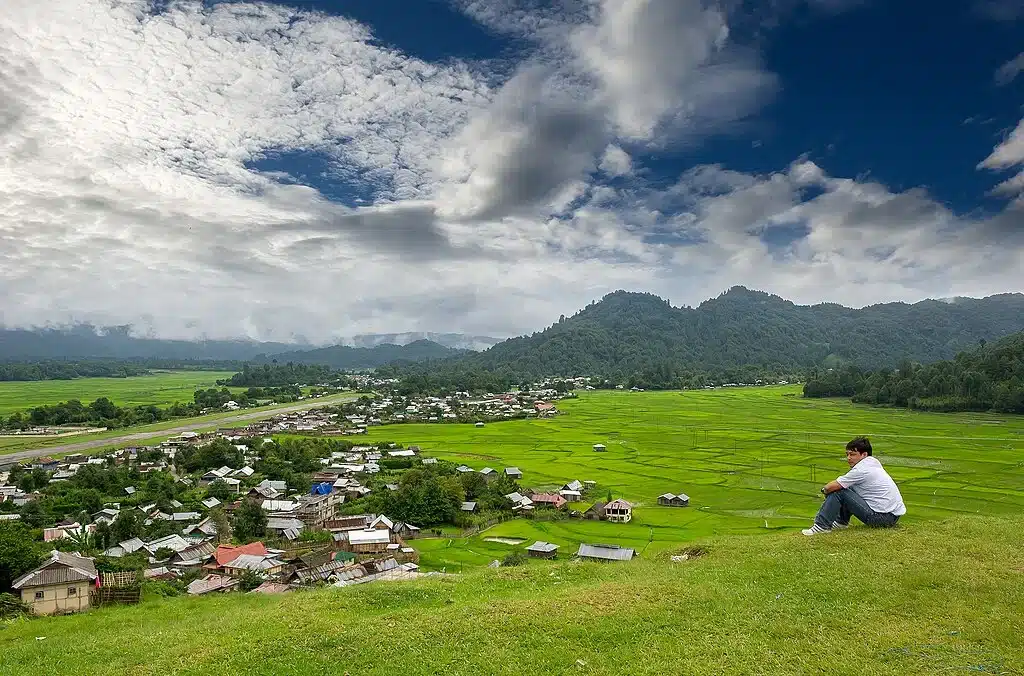Ziro isn’t cloaked in wilderness — it wears it like second skin. Nestled in Arunachal Pradesh’s Apatani Plateau, Ziro doesn’t separate the forest from the field, the sacred from the everyday. Here, pine-covered ridges, bamboo groves, and paddy fields don’t just exist — they co-exist, held together by an unspoken pact of respect.
For the Apatanis, the forest is not just something to conserve — it is something to converse with.
Agroforestry Before It Was a Trend
Long before climate scientists coined the term “agroforestry,” the Apatanis were already practicing it — integrating wet rice cultivation with fish farming, bordered by carefully preserved bamboo belts and pine patches.
No fences divide utility from reverence. Trees are planted not just for timber, but for festivals. Bamboo is harvested with ceremonies. Even leaves have seasons — and stories.
This interdependence isn’t strategy — it’s memory, ritual, and responsibility.
“Our field feed us, but it is the forest that watches over us,” says an elderly neighbor of our hosts.
Talley Valley: Ziro’s Breathing Lung
Just beyond the cultivated valley lies the Talley Valley Wildlife Sanctuary, a high-altitude haven of orchids, clouded leopards, and Mithun trails. It’s one of the few places where temperate, sub-tropical, and alpine vegetation meet — creating a botanical overlap that is rare even in biodiversity-rich Northeast India.
This isn’t a safari park. There are no curated trails. You walk through moss-laced silence, across hanging bridges, and under the gaze of hornbills — who might just decide to lead or ignore you.

Snippets from the Forest-Valley Life
- Birds as Timekeepers
Locals note the arrival of the Himalayan Cuckoo as the sign to start sowing. The Great Hornbill’s flight is believed to bring omens — of birth, marriage, or war. - Tree Carvings in Siiro
In some pockets, trunks are carved with ancestral markings — small lines and patterns representing clans and stories. The trees, in turn, are never cut. - Bamboo and Belief
Certain groves are considered taboo zones — where hunting, cutting, or even loud laughter is forbidden. Children are told these are places “where the spirits rest.”
House Posts That Speak
Apatani homes often have central wooden posts carved with symbolic motifs — some depict animals, others ancestors or forest spirits. These aren’t decorative — they are reminders. One elderly man explained, “We plant a tree knowing it will become a pillar. The pillar then remembers us when we’re gone.”
Know Before You Go
- Best time: March to May (lush forests) and October (after harvest)
- Where to stay: Homestays in Hong, Hari or Hija villages; guided treks into Talley Valley can be arranged locally
- Etiquette tips:
- Don’t litter near groves — many are sacred
- Always ask before photographing house carvings
- Avoid entering forest paths alone — take a local guide
Ziro doesn’t guard its forests — it grows with them. The trees here are not distant beings to be watched. They are woven into homes, customs, songs, and silences. And if you walk gently enough, they might let you in — not as a visitor, but as someone who knows how to listen.
In Ziro, the forest isn’t beyond the fence — it begins with your doorway.”
















